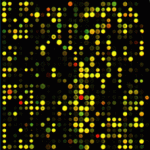Genomics
|
4 december 2018 11:00:05 |
| Ranking noncanonical 5` splice site usage by genome-wide RNA-seq analysis and splicing reporter assays [RESEARCH] (Genome Research) |
|
Tweet Most human pathogenic mutations in 5` splice sites affect the canonical GT in positions +1 and +2, leading to noncanonical dinucleotides. On the other hand, noncanonical dinucleotides are observed under physiological conditions in ~1% of all human 5`ss. It is therefore a challenging task to understand the pathogenic mutation mechanisms underlying the conditions under which noncanonical 5`ss are used. In this work, we systematically examined noncanonical 5` splice site selection, both experimentally using splicing competition reporters and by analyzing a large RNA-seq data set of 54 fibroblast samples from 27 subjects containing a total of 2.4 billion gapped reads covering 269,375 exon junctions. From both approaches, we consistently derived a noncanonical 5`ss usage ranking GC > TT > AT > GA > GG > CT. In our competition splicing reporter assay, noncanonical splicing was strictly dependent on the presence of upstream or downstream splicing regulatory elements (SREs), and changes in SREs could be compensated by variation of U1 snRNA complementarity in the competing 5`ss. In particular, we could confirm splicing at different positions (i.e., –1, +1, +5) of a splice site for all noncanonical dinucleotides `weaker` than GC. In our comprehensive RNA-seq data set analysis, noncanonical 5`ss were preferentially detected in weakly used exon junctions of highly expressed genes. Among high-confidence splice sites, they were 10-fold overrepresented in clusters with a neighboring, more frequently used 5`ss. Conversely, these more frequently used neighbors contained only the dinucleotides GT, GC, and TT, in accordance with the above ranking. |
| 99 viewsCategory: Bioinformatics, Genetics, Genomics |
 Genetic analysis of isoform usage in the human anti-viral response reveals influenza-specific regulation of ERAP2 transcripts under balancing selection [RESEARCH] (Genome Research) Genetic analysis of isoform usage in the human anti-viral response reveals influenza-specific regulation of ERAP2 transcripts under balancing selection [RESEARCH] (Genome Research)Evolutionary conservation of Y Chromosome ampliconic gene families despite extensive structural variation [RESEARCH] (Genome Research) 
|
| blog comments powered by Disqus |
MyJournals.org
The latest issues of all your favorite science journals on one page
The latest issues of all your favorite science journals on one page



